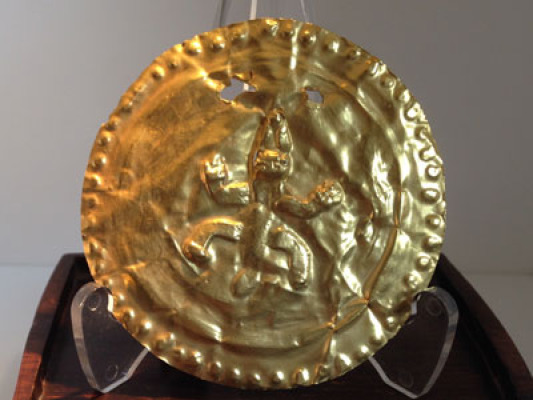Period Jewels
Ming Dynasty Gold Bat OrnamentA Ming Dynasry (1368-164), masterful gold ornament in the form of a bat; an emblem for "Happiness" in Chinese culture as the word for "bat" (Fu) is a homophone (sounds like) for the word for "Happiness". The delicate filigree work used to execute the charming creature is impressive. The purity of gold is 18-22K. The bat weighs 3.10 grams |
Ming Dynasty Gold DragonA rare masterpiece of Ming Dynasty (1368-1644} gold filigree formed as a rampant dragon dress ornament. Adorned with artistic charm, note the details of the dragon's features; undulating floral elements, complete with the now vacant, centered cup mount once occupied by a pearl; the "pearl of wisdom" 7.75 grams of 18-22K natural gold. 2 1/4 inches Pictured also is the verso of the ornament. |
Ming Dragon Fish EarringsFrom China, a stunning pair of Ming Dynasty (1368-1644) 18K earrings in the form of the mythical dragon fish. Once overlaid in part with Kingfisher feathers, these fierce creatures are charming and masterfully executed. Note the fine filigree work that forms the heads. 10.73 grams |
Edwardian Diamond, Natural Pearl BroochInternational concert pianist, Buenaventura Galvez de Reyes, known as La Galvez, is my great grandmother. She is mentioned in Dr. Jose Rizal's late 19th century novel, Noli Me Tangere; long considered as their nation's literary masterpiece by the Filipino people. This brooch was hers, given to her by my Great Grandfather, Jose Reyes who founded the first inter-island shipping company in the Philippines. |
19th century silver and gold, turquoise, pearl, swallow broochThis charming creature perched upon a lady's lapel will astonish with its delicacy and the meticulous setting of turquoise cabochons and pearls. But wait! The swallow moves en tremblant to the touch! |
A superb 18K gold and Jadeite, Dragon BuckleThis amazing natural color, untreated jadeite and 18K gold buckle shows two dragons chasing after the pearl of wisdom. It measures 2.75 x 1.75 inchesCirca mid 20th century. Signed Loong Shing. |
Edwardian Platinum, (natural) Zircon RingThe turn of the century platinum and 18K yellow gold ring features a bright yellow Zircon weighing approx. 5.20 carats. Not to be confused with cubic zirconium, this natural stone is particularly rare due to its near pure yellow hue. 21 old mine cut diamonds grace this ring and weigh altogether approx. 2 carats. |
Cartier Silver and Gold Cigarette Case/LighterA vintage sterling silver and 14K gold cigarette case/lighter by Cartier.Circa 1950's. 3 7/16 x 3 x 11/16 inches |
Exotic Pendant NecklaceA tasteful assemblage of wondrous elements - Persian turquoise, Burmese rubies, 22K gold pendant from India, a gorgeous briolette diamond... |
Vintage Turquoise Silver CuffA strong vintage, unsigned Navajo, blackened sterling silver cuff, bezel set with 21 natural turquoise cabochons with decorated, scalloped borders and ground. 1 3/4 inches tapering to 1 3/8 inches wide. 7 inch outside length. 5 1/2 inch inside length. 141.69 grams |
Georgian Silver and Gold RingA wonderful Georgian, late 18th c. - early 19th c., silver, gold and diamond heart/bow ring Russian hallmarks |
Gold bangle - Indonesia - 19th centuryWorthy of any museum's collection, this rare bangle is an example of the masterful work done by the 19th century South Asian goldsmiths. The applied wire work and the red staining of the gold are quintessential elements found in early Indonesian jewels. A metallic bead contained within the bangle rolls around as the wearer strolls, making a delightful sound, thus alerting others of her arrival. |
19thc. Indian "Not a Polki" Diamond Ring"Not a Polki" means NOT a "polki", which traditionally means an uncut diamond. Amazingly brilliant for a diamond that is likely cut shallow, this stone underscores the meaning of ADAMANTINE luster!This diamond weighs approx. 2 carats and shines in the darkness as it reflects the slightest trace of light in a room. The top of the diamond is cut as a large table with crown facets and the stone is beautifully, scallop bezeled with a fleur-de-lys gallery, all in 22K gold. The gold has a lovely patina (oxidation.....yes, gold oxidizes) and the ring is suitable for all occasions! |
Rare 18th century Pinya crucifix - PhilippinesNote the devotional red staining to the gold by the South East Asian goldsmith."The baroque splendor of the very rare tinik (thorn) or pinya (pineapple) cross is a Portuguese synthesis of the Javanese style of the late Majapahit period." Ramon N. Villegas from his book KAYAMANAN: The Philippine Jewelry Tradition |
Mexican Modernist Silver BroochMidcentury Mexican Modern - a vintage Taxco silver brooch circa 1950. Signed 3M within the Taxco Silver circle. 3M has been loosely attributed to Miguel Melendez who apprenticed with William Spratling's Taller de las Delicias in the 1940's and then went to work for Los Castillo before going out on his own. 1 1/2" Item #226MSB |
Precolumbian Gold Breast PlateThe high karat Precolumbian gold breast plate from Veraguas, W. Panama dates to the 15th c. and is of hammered native gold. The animal depicted is most likely the Panamanian crocodile or Largarto Aguja.13.06 grams 22 karat+ gold 2 11/16" diameter Provenance: Dale Flores Collection |
Tairona Pre Columbian gold frogThis is a rare example of a Pre-columbian, gold tree frog pendant produced by the Tairona, a Pre-Hispanic, indigenous tribe from Colombia. It measures 2" from snout to tail. circa 14th c. |
15K and 18K Assyrian Revival Brooch circa 1845Inspired by the archeological discoveries at Ninevah in 1842, jewelry design of the period reflected the public fascination for the exotic images of ancient Assyria such as this depiction of a deified King Arshubanipal. The verso reveals a glass compartment, typical of Victorian brooches, into which, a sentimental locket of hair could be inserted and worn close to the heart. |

| FRENCH ART NOUVEAU, 18K gold, natural pearl and natural, vivid pink sapphire and diamond necklace byHenry Spaulding, an American from Chicago, was employed by Tiffany and was sent to Paris to direct Tiffany operations in there, where he managed to forge friendships with the upper crust and develop Tiffany's popularity amongst the royalty of Europe. After some time he came back to Chicago to open a store in his name. Spaulding and Company was considered as one of the top stores in the US. He then opened a shop next to Tiffany and Co. in Paris, where this wonderfully feminine piece of artistic history was made. Spaulding was also on the committee for the Statue of Liberty. |
Belle Epoque BroochBelle Epoque brooch by J.E. Caldwell. Platinum, diamonds, emeralds and pearls circa 1900. |
Italian Family Crest BroochItalian family crest brooch of enamel, gold, silver, diamonds and rubies. French Hallmarks. After 1838. |
French Court RingFrench court ring of diamonds (approx. 5.00 cts) silver, 18K gold, and enamel. Paris circa 1838. |
Phoenix BroochPhoenix Brooch of approx. 5.50 cts. of old mine cut diamonds set in silver on gold. Mid 19th century Russia. |
Belle Epoque NecklaceA Belle Epoque silver, diamond and 18K gold necklace fully signed by Mellerio dits Meller Paris circa 1890. This wonderfully feminine necklace transforms into two bracelets with ease.“A large and well established family originating from Lombardy and resident in France since the time of King Francois I. Documented as goldsmiths from 1613." * Emperor Napolean III was a constant customer from 1853 and Queen Isabella of Spain was also a customer. French nobility and aristocrats from throughout the Continent were regular customers of this Maison of renown; with salons in Paris, Biarritz, Baden-Baden and Madrid. |
English PocketwatchThis 18K yellow, rose, white and green gold English pocketwatch is set with emeralds, diamonds and rubies. Dated to 1832 the watch was sold by the firm of Howell and James. The legendary gem specialist Edwin Streeter first worked as a salesman at the age of 19 at Howell and James. |


 Detailed view of Ming Dynasty Gold Bat Ornament
Detailed view of Ming Dynasty Gold Bat Ornament
 Detailed view of Ming Dynasty Gold Dragon
Detailed view of Ming Dynasty Gold Dragon
 Detailed view of Ming Dragon Fish Earrings
Detailed view of Ming Dragon Fish Earrings
 Detailed view of Edwardian Diamond, Natural Pearl Brooch
Detailed view of Edwardian Diamond, Natural Pearl Brooch
 Detailed view of 19th century swallow brooch
Detailed view of 19th century swallow brooch
 Detailed view of Dragon Buckle
Detailed view of Dragon Buckle Second view of Dragon Buckle
Second view of Dragon Buckle
 Detailed view of Edwardian Platinum, (natural) Zircon Ring
Detailed view of Edwardian Platinum, (natural) Zircon Ring Second view of Edwardian Platinum, (natural) Zircon Ring
Second view of Edwardian Platinum, (natural) Zircon Ring
 Detailed view of Cartier Silver Cigarette case and lighter
Detailed view of Cartier Silver Cigarette case and lighter Second view of Cartier Silver Cigarette case and lighter
Second view of Cartier Silver Cigarette case and lighter
 Detailed view of Exotic Pendant Necklace
Detailed view of Exotic Pendant Necklace Second view of Exotic Pendant Necklace
Second view of Exotic Pendant Necklace
 Detailed view of Vintage Turquoise Silver Cuff
Detailed view of Vintage Turquoise Silver Cuff Second view of Vintage Turquoise Silver Cuff
Second view of Vintage Turquoise Silver Cuff
 Detailed view of Georgian Silver and Gold Ring
Detailed view of Georgian Silver and Gold Ring Second view of Georgian Silver and Gold Ring
Second view of Georgian Silver and Gold Ring
 Detailed view of Gold bangle - Indonesia - 19th century
Detailed view of Gold bangle - Indonesia - 19th century Second view of Gold bangle - Indonesia - 19th century
Second view of Gold bangle - Indonesia - 19th century
 Detailed view of 19thc. Indian "Not a Polki" Diamond Ring
Detailed view of 19thc. Indian "Not a Polki" Diamond Ring Second view of 19thc. Indian "Not a Polki" Diamond Ring
Second view of 19thc. Indian "Not a Polki" Diamond Ring
 Detailed view of Rare 18th century Pinya crucifix – Philippines
Detailed view of Rare 18th century Pinya crucifix – Philippines
 Detailed view of Mexican Midcentury Modern
Detailed view of Mexican Midcentury Modern
 Detailed view of Precolumbian Gold Breast Plate
Detailed view of Precolumbian Gold Breast Plate
 Detailed view of Tairona Precolumbian gold frog
Detailed view of Tairona Precolumbian gold frog Second view of Tairona Precolumbian gold frog
Second view of Tairona Precolumbian gold frog
 Detailed view of Assyrian Revival Brooch circa 1845
Detailed view of Assyrian Revival Brooch circa 1845 Second view of Assyrian Revival Brooch circa 1845
Second view of Assyrian Revival Brooch circa 1845





 Detailed view of English Pocketwatch
Detailed view of English Pocketwatch